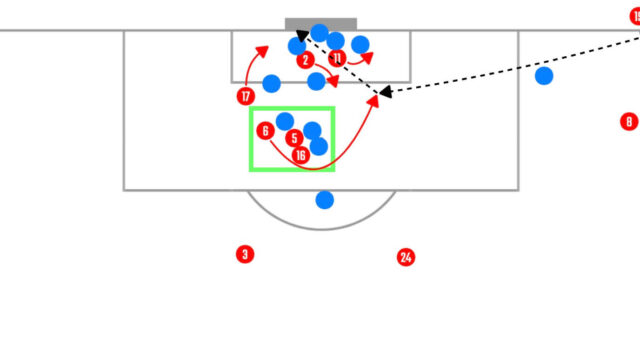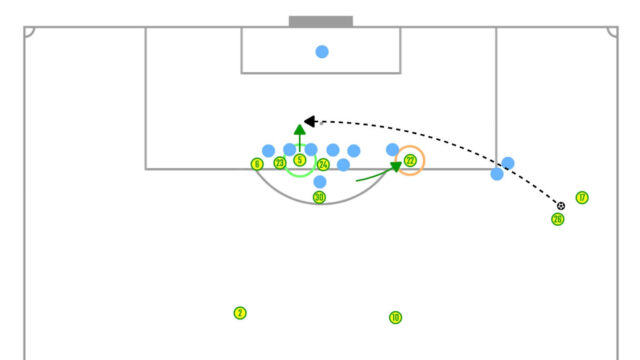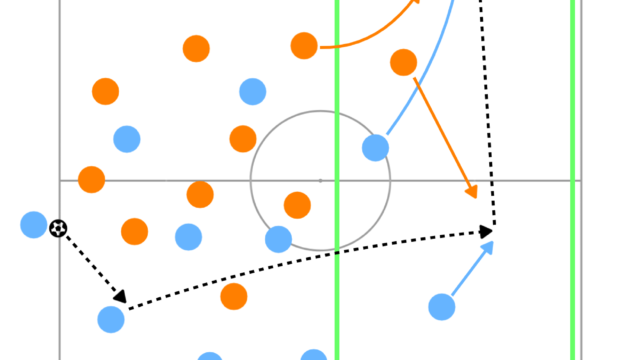How to Defend Throw-ins? [Football Tactical Analysis]
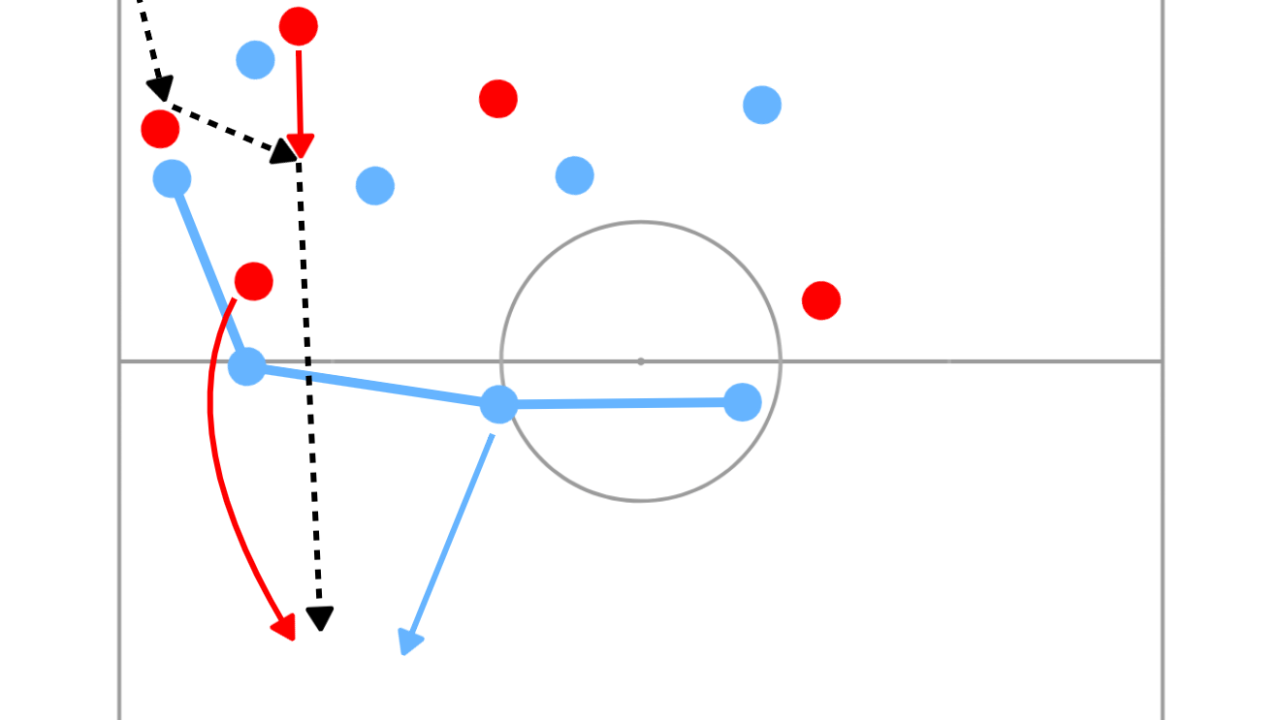
Introduction
Set pieces in football play vital roles in the game and many teams focus on this area in more detail as there are specific coaches or analysts of set pieces in top clubs. However, throw-ins are not trained as much as other set pieces such as corner kicks or free kicks. The characteristics of throw-in were already discussed in the article below, so I recommend you reading this if you are interested in the example of Liverpool.
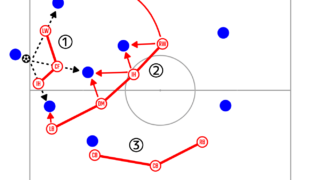
In this article, the defensive perspective of throw-in is going to be discussed. The reason is that the method of defending throw-in should be considered before planning how to attack throw-in. In the process of planning some routines of attacking throw-in, it is impossible to ignore the opposition defending structure. Therefore, the way of defending throw-in is going to be analysed in this article, and the tactics of attacking throw-in will be discussed in the next article.
Pressing in the Midfield or Attacking Third
In this article, the purpose of defending is divided into two categories, pressing and defending the final third. In other words, trying to win the ball or defending the goal. One thing which is important to remember is that the key is the balance between them. Even when pressing, the defenders need to think about preventing the opposition attackers from exploiting the space in behind and threatening the goal or even when defending the goal in the final third, the attackers might be required to press on the ball to win it. Thus, it is important to observe how much the team tries to apply pressure on the ball or defend the goal to understand the balance of the team.
In terms of pressing in the midfield or the attacking third, there are mainly two ways of pressing. The first one is trying to lock them in a wide area with a touchline to win the ball and play counterattacks in the congested situation. Another one is preventing them from playing forward to let them play back and push up the lines to press high in the organised situation. The differences between them are going to be examined in detail.
The first type of pressing is used by teams who like to play in transitions such as Liverpool or Bayern München.

They do not allow the opponents to throw the ball even backwards and force them to throw it in the air to compete an aerial duel. Most of all outfield players shuffle across to the ball side to increase the probability of winning second balls. Then, as soon as regaining the ball, they try to play forward to exploit the unbalanced opposition defence.
However, they leave huge space in the opposite side, and this is the possible weakness. If the opposition team manages to switch the ball to the opposite side, it turns into the favourable situation for the opposition team to play forward and play fast attacks.
On the other hand, the second type of pressing can cover this weakness and still make it possible to apply pressure.

In this defensive structure, it is possible for the opposition team to throw the ball backwards. However, this is the trigger for the defending team to push the lines up to apply pressure forwards. The pressing starts after the ball is thrown to the opposition player, so it is more organised situation than the situation in the first type of pressing mentioned earlier.
In terms of weaknesses, they cannot make the most of the characteristic of throw-in which it is technically difficult for the attacking team to control the ball. If the ball is thrown in the air towards the head or chest of the opposition player, the chance of winning the ball might be higher than when the ball is played on the ground. However, by allowing the opposition team to throw the ball backwards without any pressure, the valuable chance disappears.
In short, if the team is strong in transitions, they should press with the first type of pressing and if the team is strong in organised situation, they should utilise another one.
Additionally, one of the common weaknesses of pressing against throw-in is that the back line tends to be dragged out easily. In many cases, the opposition ball side winger drops back to receive the ball due to the lack of distance the ball can be thrown and the fullback follows the movement. Then, to cover the space behind the fullback and mark the opposition striker drifts wide to come close to the ball, the ball side centre back is also likely to be drawn outside. Additionally, due to the tendency of marking the opposition attackers tightly in throw-in, the chance for the opposition attackers of running past the markers becomes higher.

When the opposition team succeeds in keeping the possession in the congested area and playing through in behind, even one of the centre backs can be run past and the attacking team can play fast attacks against two or three defenders.
To overcome this common weakness, it is possible to get the defenders to defend zonally or refrain from competing the first aerial duel to prioritise to cover the space behind them. The first solution is one of the characteristics of the second type of pressing which emphasises to cover the space in behind initially, and the second solution can be useful in pressing with the first type which they try to lock the opposition team in a wide area.
Overall, there are mainly two ways of pressing in the midfield or attacking third. Both have strengths and weaknesses, so it should be chosen depending on the characteristics of the own team.
Defending the Final Third
When defending throw-in in the own final third, the key is the degree of marking type. It can be categorised into three types, which are man marking, man marking in a wide area or zonal marking.
Man Marking
The biggest characteristic of this type is that the positions of defending players depend on the positions of attacking players. As a result, even a centre back follows an opposition attacker drifting outside until it becomes possible to swap each marker with one of the other teammates.

The strengths are easy for each defender to understand what to do or a few attackers can remain up front to chase the ball cleared away. However, as most of all players have an opposition player to mark, if one of them is beaten by an opposition attacker, a 1v2 situation occurs and it is difficult to cover each other. Additionally, the ball side centre back is likely to be dragged out, so the space in front of the goal can be huge for the opposition attacker in the box.
Man Marking in a Wide Area
In order to overcome the weakness that there is huge space in front of the goal, the idea of getting both centre backs and defensive midfielders to stay in front of the goal frequently works well in terms of defending the goal. However, to cover the absence of the centre back or defensive midfielders in a wide area, more players from the midfield or forward are required to come back to defend.

This is a well-balanced defensive structure, but there is still room for being exploited in a wide area against flexible opponents. This can be solved by only keeping marking the opposition attackers well and winning each 1v1 battle in a wide area.
Zonal Marking
The last type is a totally zonal defensive structure. Not only in front of the goal but also in a wide area, the defending players defend the space rather than marking the opposition players.

The strength of this structure is that they can occupy the space well, so the opposition team will struggle to create a big gap between the defenders. Additionally, everyone respects where to defend rather than marking the opposition attackers, so they will not be disorganised easily.
However, it is difficult to defend in an underloaded situation or against an opposition player who can receive the ball in a small gap between the defenders. basically, they do not care about the number of the opposition defenders, so it is easy for the opposition team to create an overload in a wide area. Moreover, the defenders do not mark the attackers tightly, so skilful player can receive the ball in a gap because the pressure is looser than man marking.
Overall, each of them has strength and weakness, as it was in pressing, so the most important thing is understanding the differences and selecting the most suitable one in a team. From the attacking point of view, knowing the weaknesses of the defensive structure is the first step of planning routines to work them effectively.
Conclusion
In this article, how to think about defending throw-in was discussed in detail. Firstly, it was described that there are two purposes of defending throw-in mainly depending on the area of the pitch. Secondly, two ways of pressing and three ways of defending in the final third were summarised and strengths and weaknesses of them were analysed.
One thing to be forgotten is long throw-in in the final third. The main reason of this is that it does not happen frequently in the game, so the sample size is not enough to conclude something. In other words, this area can be an advantage for teams who passionately focus on long throw-in. Additionally, it is worth being written in an independent article, mainly focusing on attacking tactics of a specific team such as Brentford and then suggesting how to stop them.
I hope you enjoyed this article and please wait for the next one.
